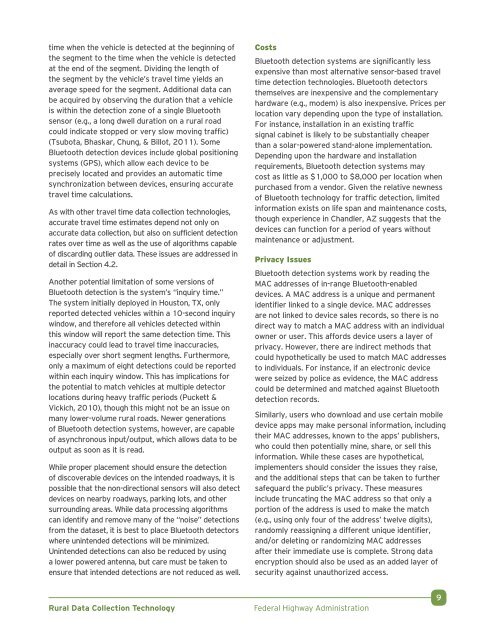Rural Data Collection Technology - FHWA Operations - U.S. ...
Rural Data Collection Technology - FHWA Operations - U.S. ...
Rural Data Collection Technology - FHWA Operations - U.S. ...
- No tags were found...
Create successful ePaper yourself
Turn your PDF publications into a flip-book with our unique Google optimized e-Paper software.
time when the vehicle is detected at the beginning ofthe segment to the time when the vehicle is detectedat the end of the segment. Dividing the length ofthe segment by the vehicle’s travel time yields anaverage speed for the segment. Additional data canbe acquired by observing the duration that a vehicleis within the detection zone of a single Bluetoothsensor (e.g., a long dwell duration on a rural roadcould indicate stopped or very slow moving traffic)(Tsubota, Bhaskar, Chung, & Billot, 2011). SomeBluetooth detection devices include global positioningsystems (GPS), which allow each device to beprecisely located and provides an automatic timesynchronization between devices, ensuring accuratetravel time calculations.As with other travel time data collection technologies,accurate travel time estimates depend not only onaccurate data collection, but also on sufficient detectionrates over time as well as the use of algorithms capableof discarding outlier data. These issues are addressed indetail in Section 4.2.Another potential limitation of some versions ofBluetooth detection is the system’s “inquiry time.”The system initially deployed in Houston, TX, onlyreported detected vehicles within a 10-second inquirywindow, and therefore all vehicles detected withinthis window will report the same detection time. Thisinaccuracy could lead to travel time inaccuracies,especially over short segment lengths. Furthermore,only a maximum of eight detections could be reportedwithin each inquiry window. This has implications forthe potential to match vehicles at multiple detectorlocations during heavy traffic periods (Puckett &Vickich, 2010), though this might not be an issue onmany lower-volume rural roads. Newer generationsof Bluetooth detection systems, however, are capableof asynchronous input/output, which allows data to beoutput as soon as it is read.While proper placement should ensure the detectionof discoverable devices on the intended roadways, it ispossible that the non-directional sensors will also detectdevices on nearby roadways, parking lots, and othersurrounding areas. While data processing algorithmscan identify and remove many of the “noise” detectionsfrom the dataset, it is best to place Bluetooth detectorswhere unintended detections will be minimized.Unintended detections can also be reduced by usinga lower powered antenna, but care must be taken toensure that intended detections are not reduced as well.CostsBluetooth detection systems are significantly lessexpensive than most alternative sensor-based traveltime detection technologies. Bluetooth detectorsthemselves are inexpensive and the complementaryhardware (e.g., modem) is also inexpensive. Prices perlocation vary depending upon the type of installation.For instance, installation in an existing trafficsignal cabinet is likely to be substantially cheaperthan a solar-powered stand-alone implementation.Depending upon the hardware and installationrequirements, Bluetooth detection systems maycost as little as $1,000 to $8,000 per location whenpurchased from a vendor. Given the relative newnessof Bluetooth technology for traffic detection, limitedinformation exists on life span and maintenance costs,though experience in Chandler, AZ suggests that thedevices can function for a period of years withoutmaintenance or adjustment.Privacy IssuesBluetooth detection systems work by reading theMAC addresses of in-range Bluetooth-enableddevices. A MAC address is a unique and permanentidentifier linked to a single device. MAC addressesare not linked to device sales records, so there is nodirect way to match a MAC address with an individualowner or user. This affords device users a layer ofprivacy. However, there are indirect methods thatcould hypothetically be used to match MAC addressesto individuals. For instance, if an electronic devicewere seized by police as evidence, the MAC addresscould be determined and matched against Bluetoothdetection records.Similarly, users who download and use certain mobiledevice apps may make personal information, includingtheir MAC addresses, known to the apps’ publishers,who could then potentially mine, share, or sell thisinformation. While these cases are hypothetical,implementers should consider the issues they raise,and the additional steps that can be taken to furthersafeguard the public’s privacy. These measuresinclude truncating the MAC address so that only aportion of the address is used to make the match(e.g., using only four of the address’ twelve digits),randomly reassigning a different unique identifier,and/or deleting or randomizing MAC addressesafter their immediate use is complete. Strong dataencryption should also be used as an added layer ofsecurity against unauthorized access.<strong>Rural</strong> <strong>Data</strong> <strong>Collection</strong> <strong>Technology</strong>Federal Highway Administration9
















